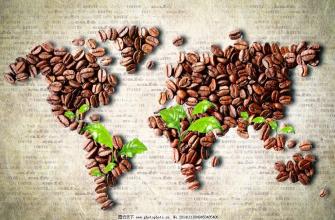Introduction to the description method of Brand Taste and Flavor of Colombian Sun Coffee
Introduction to the description method of Brand Taste and Flavor of Colombian Sun Coffee
The territory has towering mountains, highlands, plateaus, valleys and plains, with diverse topography. The geology of the area belongs to fertile, well-drained volcanic soil with a depth of nearly two meters and a dark brown or brown surface soil. The biggest advantage of the place is that the soil fertility is maintained through the cycle of organic matter, using the withered leaves of surrounding trees or plant roots as fertilizer in 2010-2012, it continuously won the high score of CR92~94, the authoritative coffee evaluation website in the United States. Thus it can be seen that the coffee flavor of the raw beans in this area is very diverse, with different soil types, microclimate and countless native coffee species, which makes the coffee produced in the town have obvious differences and characteristics. This batch is produced by the Sherisa Cooperative near Dilla town. The cooperative was founded in 1976 and is currently a member of the SCFCU of the Sidamo Farmers' Cooperative Union. We have screened the coffee again, and the selected batch has excellent flavor performance. Flavor tends to honey, citrus, coffee flowers ● Origin: Guji,Sidamo,Ethiopia beans: Heirloom altitude: 1800-2000m processing plant: Shilicho Cooperative treatment: washing method, scaffolding drying mechanical drying harvest method: manual harvest and baking degree: medium and shallow baking time: 2016 flavor features: blueberry sweetness with lemon aromas, rich flower and fruit aromas, peach honey aromas with surprisingly bright acidity and full berry aromas
The "Guji producing area" is located in the southeast of the Gedeo area where Jega produces snow caffeine, in the wilderness of 2100 meters above sea level, but it is higher than that of the Yega producing area, with the highest elevation of more than 2600 meters, much higher than the average Sidama, and a larger area. The coffee produced by Guji is very rich and unrestrained in flavor and can challenge Yega Snow Coffee.
Each fruit contains 2 coffee beans (except one pod of single bean Peaberry). The fruit of this kind of coffee contains only one coffee bean. Normally, 5% of each batch of coffee beans is a single pod. Coffee beans can be roasted and washed after drying and treatment: the peel, pulp and mucous membrane are removed by washing and fermentation. This method is also known as the complete washing method (Fully Washed). Shampoo is the most common way for most coffee-producing countries in the world to handle Arabica coffee beans. Some areas also use advanced high-pressure washing machines to clean the peel, pulp and mucous membrane of coffee beans, so fermentation is no longer needed. This method of using a high-pressure washing machine to treat coffee beans is called "Natural washing (Pulped Natural)," which is the simplest process. The fruit begins the process of sun drying without treatment after picking. This is the oldest method of treatment in existence. This method is still used in places such as Ethiopia and Brazil. Natural solarization is most common in areas where water resources are scarce. The drying process usually lasts about 4 weeks. The method of handling must be very strict to ensure that the coffee does not lose any flavor. The natural sun method requires the local climate to be extremely dry. In some areas, people use dryers to assist in the drying process of coffee fruit (the hot air of the dryer can speed up the drying process and help people control the degree of drying)

Important Notice :
前街咖啡 FrontStreet Coffee has moved to new addredd:
FrontStreet Coffee Address: 315,Donghua East Road,GuangZhou
Tel:020 38364473
- Prev

Flavor description of Salvadoran Coffee beans introduction to Grinding and Calibration method
Features of Salvadoran coffee: Salvadoran coffee is a specialty of Central America, where coffee is light, fragrant, pure and slightly sour. Flavor: balanced taste, good texture recommended roasting method: medium to deep, there are many uses ★: general Salvadoran coffee market: the best quality Salvadoran coffee is exported from January to March, 35% of the extra hard beans are exported to Germany. nineteen
- Next

Description of Coffee Flavor in Sidamo Coffee introduction to the Grinding scale of Coffee produced in different regions
Sidamo Coffee Flavor description Variety production area treatment Grinding scale first introduce the varieties of coffee. There are more than 6000 varieties of coffee trees, and there are four major coffee trees in the world. Only two kinds of coffee trees are of real commercial value and are planted in large quantities, and the quality of the coffee beans produced by other coffee trees is also better than that produced by other coffee trees. Different products
Related
- Detailed explanation of Jadeite planting Land in Panamanian Jadeite Manor introduction to the grading system of Jadeite competitive bidding, Red bid, Green bid and Rose Summer
- Story of Coffee planting in Brenka region of Costa Rica Stonehenge Manor anaerobic heavy honey treatment of flavor mouth
- What's on the barrel of Blue Mountain Coffee beans?
- Can American coffee also pull flowers? How to use hot American style to pull out a good-looking pattern?
- Can you make a cold extract with coffee beans? What is the right proportion for cold-extracted coffee formula?
- Indonesian PWN Gold Mandrine Coffee Origin Features Flavor How to Chong? Mandolin coffee is American.
- A brief introduction to the flavor characteristics of Brazilian yellow bourbon coffee beans
- What is the effect of different water quality on the flavor of cold-extracted coffee? What kind of water is best for brewing coffee?
- Why do you think of Rose Summer whenever you mention Panamanian coffee?
- Introduction to the characteristics of authentic blue mountain coffee bean producing areas? What is the CIB Coffee Authority in Jamaica?

